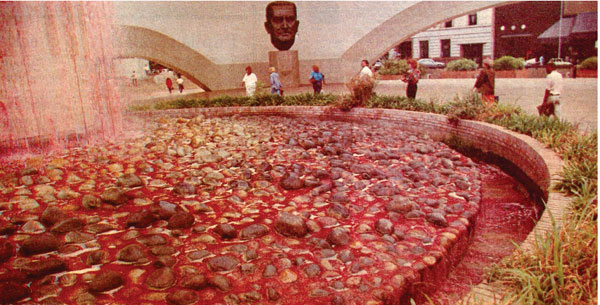
Blood Fountain
Red pigment in the water of Strijdom Square, Pretoria
29 September 1992
Photographed by the late Richard Nezar for Pretoria News
Monumental space and the uncanny
Extract from a study by Dr. Derek Hook,
Department of Social Psychology, London School of Economics and Political Science
On Tuesday the 15th November 1988, in Pretoria, South Africa, in a self-declared attempt to start the 3rd Boer war, 23-year old right-wing extremist Barend Strydom entered Strijdom Square (named after his unrelated namesake, J.G. Strijdom, former apartheid Prime Minister), and began a racially motivated shooting spree. At the same time that President P.W. Botha was expected to announce the possibility of Mandela's release, and while the visiting Mother Teresa prayed for peace at the Pretoria showground,
Strydom began firing upon unsuspecting black men and women in Pretoria's busiest public square. After killing his first victim just outside the State Theatre, Strydom, dressed in military apparel, moved through the Square, shooting and wounding another two people. In the words of Frans Legodi, a witness to the events: I heard a gunshot. I saw a white man wearing camouflaged clothes. He turned and went to the Square. I remember I saw how he shot a man and a woman and they fell down... the woman was shot in the leg. He went on shooting everyone.
The strange thing was that he was only shooting black people. Ten meters away from these first killings Strydom shot another three people. Another witness, Elbie Beneke, recalls what she saw: a man came running from the State Theatre... I saw him shoot three people. He then came closer to my car where he took a black man by the face, pushed him back and shot him at point blank range through the head. Strydom then left the Square, killing another bystander as he crossed the adjacent street. At the nearby corner of Church and Prinsloo streets he opened fire on yet another victim, before gunning down a further five victims in Prinsloo Street itself. It was here that a black civilian courageously wrestled Strydom to the ground, and held him captive until the police arrived.
Strydom had carefully picked the site of this event such that it would amplify his actions and incite a resurgence of the powerful racial division of South Africa that he believed was under threat. Significantly, a week before the Strijdom Square massacre he had visited the nearby Voortrekker Monument to pray and re-enact the Blood River vow, a clear attempt to link the murderous history of his own making to a set of historical (and ideological) precedents.
In total, Barend Strydom killed eight and wounded fourteen black men and women in his vicious and racist rampage, an act he 'legitimised' in his bid for amnesty as an act of war to protect the Afrikaner nation. On 29 September 1992, the day Strydom was released from prison on the basis of political amnesty, a large amount of red dye was poured into the fountain on the Square: an act that seemed to iconoclastically subvert the cultural and ideological meaning of the Square, inverting its vision of Afrikaner freedom into a potent reminder of whose freedoms it had excluded. The disturbing effects of this act were reported by the Pretoria News (1992) with the lead-in: 'Strange symbolism'; its report made mention of the political ambiguity of the event: the water in the Strijdom Square fountain ran red today. Who put the dye into the water is unknown. Was it right-wingers reminding people of the atrocities committed on the square... or friends and relatives of the victims of the infamous shooting spree? (p.1).
Artist Jacques Coetzer later claimed responsibility for putting dye in the fountain. Reluctant to be stereotyped as of left or right political persuasion, Coetzer said that his motivation was 'to wrench South Africans from a placid and spineless acceptance of horror'. Fortunately however, this account of Strijdom Square and of the ideological affects of uncanny doubling within its domain does not end here. At approximately 5 a.m. on the morning of the 31st of May 2001, the gigantic Strijdom head collapsed into an underlying parking lot, taking along with it a large section of the Square. A newspaper article alluded to the oddity of this coincidence: The bronze bust of... Strijdom, the 'Lion of the North' crashed into a 10 m-deep chasm... split in two... it lay unceremoniously dumped among piles of broken concrete and dust... [The director of city-planning noted] that it was just a coincidence that the dome collapsed on the anniversary of the old Republic Day.